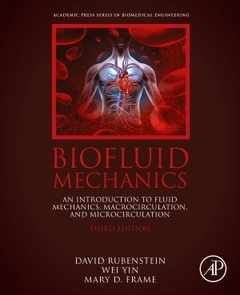Description
Biofluid Mechanics (3rd Ed.)
An Introduction to Fluid Mechanics, Macrocirculation, and Microcirculation
Biomedical Engineering Series
Authors: Rubenstein David, Yin Wei, Frame Mary D.
Language: English
Subjects for Biofluid Mechanics:
Keywords
elemental stress; kinematics; viscosity; two-phase flows; turbulent flows; buoyancy; thermodynamics; Navier-Stokes equations; Bernoulli Equation; energy balances; cardiac physiology; coronary artery disease; myocardial infarction; congenital heart disease; rheology; Windkessel Model; Womersley Flow; oscillatory blood flow; atherosclerosis; thromboembolism; aneurysm; microvascular; necrosis; edema; diffusion; vascular permeability; lymphedema; emphysema; tuberculosis; asthma; aquaporins; glaucoma; cataracts; skeletal physiology; synovial fluid; synovitis; bursitis; tubule reabsorption; dialysis; hepatitis; Buckingham Pi Theorem; dynamic similarity; velocimetry; Doppler ultrasound
125.75 €
In Print (Delivery period: 14 days).
Add to cart632 p. · 19x23.4 cm · Paperback
Description
/li>Contents
/li>Readership
/li>Biography
/li>Comment
/li>
Biofluid Mechanics: An Introduction to Fluid Mechanics, Macrocirculation, and Microcirculation, Third Edition shows how fluid mechanics principles can be applied not only to blood circulation, but also to air flow through the lungs, joint lubrication, intraocular fluid movement, renal transport, and other specialty circulations. This new edition contains new homework problems and worked examples, including MATLAB-based examples. In addition, new content has been added on such relevant topics as Womersley and Oscillatory Flows. With advanced topics in the text now denoted for instructor convenience, this book is particularly suitable for both senior and graduate-level courses in biofluids.
Part 1: Fluid Mechanics Basics 1. Introduction 2. Fundamentals of Fluid Mechanics 3. Conservation Laws 4. Introduction to Heat Transfer
Part 2: Macrocirculation 5. The Heart 6.Blood Flow in Arteries and Veins
Part 3: Microcirculation 7. Microvascular Beds 8. Mass Transport and Heat Transfer in the Microcirculation 9. The Lymphatic System
Part 4: Specialty Circulations 10. Ventilation/Perfusion in the Lung 11. Intraocular Fluid Flow 12. Lubrication of Joints and Transport in Bone 13. Flow Through the Kidney 14. Splanchnic Circulation: Liver and Spleen
Part 5: Modeling and Experimental Techniques 15. In silico Biofluid Mechanics 16. In vitro Biofluid Mechanics 17. In vivo Biofluid Mechanics
Upper level undergraduate and graduate students in biomedical engineering and mechanical engineering
Dr. Yin conducts research into coronary artery disease, specifically how altered blood flow and stress distribution affect platelet and endothelial cell behavior and lead to cardiovascular disease initiation.
The focus of Dr. Frame’s research is in integrating signal transduction events with physical properties of blood flow at the microvascular level, with the long term research goal of understanding the two phase question of how solute distribution and transport are coupled in the microcirculation.
- Uses language and math that is appropriate and conducive for undergraduate and first-year graduate learning
- Contains new worked examples and end-of-chapter problems
- Covers topics in the traditional biofluids curriculum, also addressing other systems in the body
- Discusses clinical applications throughout the book, providing practical applications for the concepts discussed
- Includes more advanced topics to help instructors teach an undergraduate course without a loss of continuity in the class




